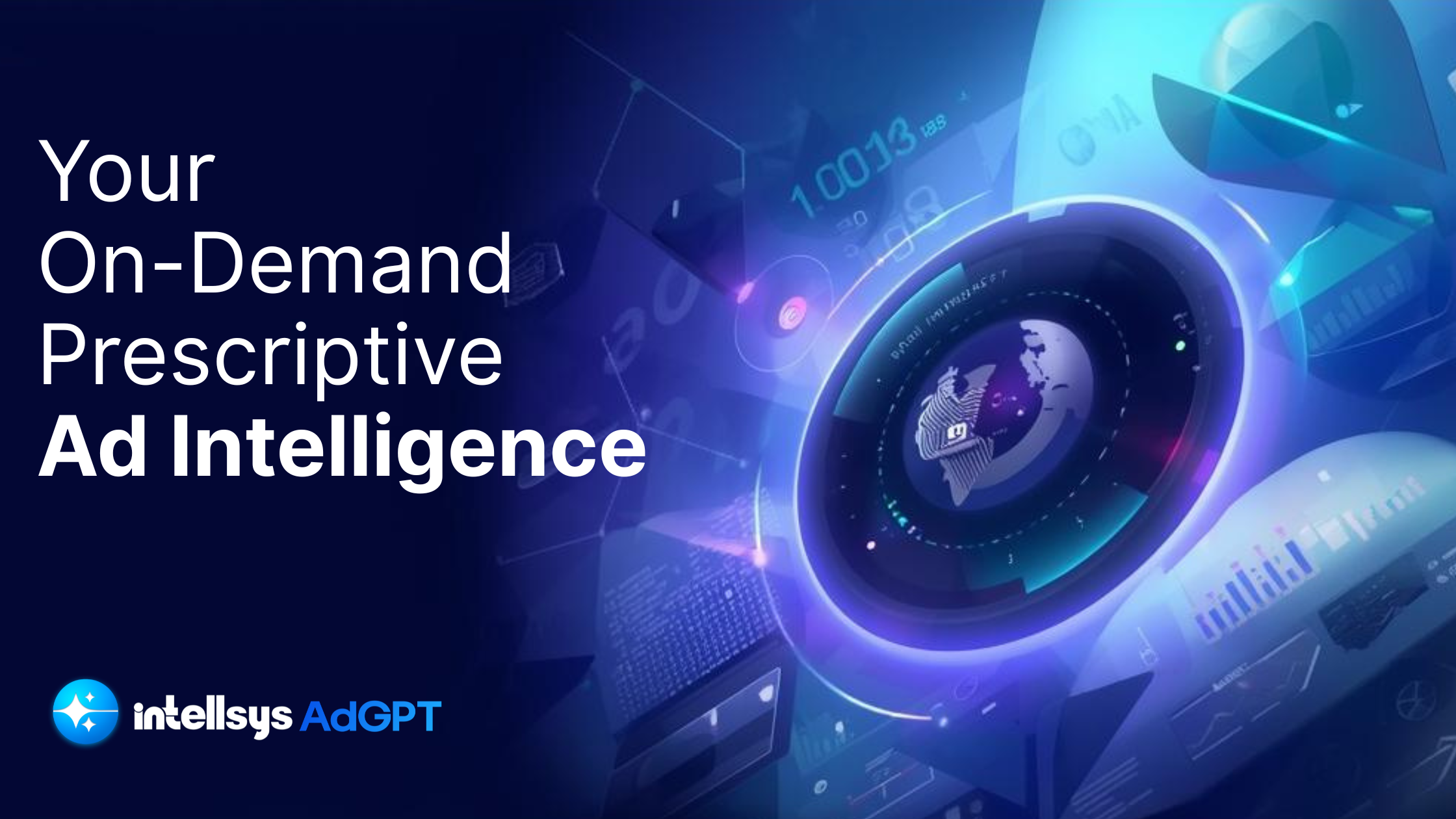From Dashboards to Decisions: How Intellsys AdGPT Powers Prescriptive Ad Intelligence

The marketing landscape has fundamentally shifted. For decades, marketers relied on dashboards of static repositories of historical data that answered only one question: "What happened?" Today's winners ask a radically different question: "What should I do now?" This shift from passive observation to prescriptive action defines the era we're entering, and Intellsys AdGPT is leading the charge.
Why Dashboards Are Failing Modern Marketers
Traditional marketing dashboards have become a paradox. While they collect more data than ever real-time metrics from 200+ advertising platforms, countless integrations, and hourly refreshes they've paradoxically made decision-making harder, not easier.
The average CMO manages data from Google Ads, Meta Ads, The Trade Desk, Shopify, Amazon, LinkedIn, and dozens of other platforms. Each sends conflicting metrics. CAC rises on one platform while ROAS surges on another. Team members argue about what the numbers mean. Meeting rooms are filled with debate over definitions, data accuracy, and what actions to prioritize. By the time alignment is reached, the moment has passed.
This phenomenon dashboard drift occurs when the sheer volume of data overwhelms decision-making capacity. Gartner research shows that 54% of corporate strategists are now exploring prescriptive analytics to move beyond this trap, while another 19% are already in deployment or pilot stages. The data paradox is real: more information hasn't yielded faster, better decisions.
The Cost of Confusion
According to recent marketing intelligence studies, teams spend an average of 8-12 hours weekly on dashboard interpretation and report building. That's time stolen from strategy, optimization, and growth. Meanwhile, competitors using AI-powered prescriptive intelligence are compressing decision cycles from days to minutes, moving from "What happened?" through "Why did it happen?" directly to "Here's what we should do next."
The traditional analytics stack: Tableau, Power BI, Looker, Qlik Sense were designed for a different era: when dashboards were quarterly insights, not real-time commands. Today's marketing moves at algorithmic speed. Static visualizations can't keep pace.
What Is Prescriptive Ad Intelligence?
For context, most platforms have evolved through three analytics stages:
Descriptive Analytics answers "What happened?" Historical data, aggregated metrics, trend lines. Every dashboard does this.
Predictive Analytics answers "What will happen?" Using machine learning, regression models, and neural networks, these platforms forecast customer behavior, seasonal trends, and campaign outcomes. Platforms like Adobe Experience Cloud and Factors.ai excel here.
Prescriptive Analytics answers "What should we do?" This is the frontier and it's where Intellsys AdGPT operates.
Prescriptive analytics builds on predictive models by adding a critical layer: recommended actions tied to measurable outcomes. A bank doesn't just predict which customers will churn; it recommends the specific offer, timing, and channel to retain them. An e-commerce brand doesn't just forecast demand; it prescribes price adjustments, inventory levels, and promotional tactics. A performance marketer doesn't just see that CPL is rising; they receive step-by-step playbooks to fix it, complete with projected impact.
Why Prescriptive Intelligence Is The Competitive Edge
Prescriptive analytics drives three essential business outcomes:
1. Speed to Decision: Traditional analytics require human interpretation. Prescriptive intelligence eliminates interpretation: it surfaces the move, explains the reasoning, and shows the projected outcome. Decisions that took days now take minutes.
2. Reduced Decision Friction: When recommendations are transparent, auditable, and tied to specific business goals, teams align faster. No more circular debates about what the data "really" means. The logic is explicit, testable, and visible to all stakeholders.
3. Compounding Results: Each decision feeds the next. Prescriptive systems learn which recommendations perform best, refine their models, and continuously improve their recommendation accuracy. Over time, the quality of decisions accelerates.
According to HCL Software's 2025 research, prescriptive analytics is increasingly becoming the standard for enterprise marketing teams pursuing hyper-personalization at scale. The market is projected to grow significantly as organizations recognize that data-driven decision-making requires not just insights, but actionable directives.
Introducing Intellsys AdGPT: How It Works
Intellsys AdGPT transforms the ad intelligence experience by combining three core capabilities:
1. Unified Data Intelligence Across 200+ Integrations
AdGPT ingests data from every major advertising and marketing platform Google Ads, Meta Ads, Amazon Ads, The Trade Desk, Shopify, LinkedIn, TikTok, and 190+ others. Data refreshes hourly, ensuring real-time accuracy. But unlike traditional dashboards, this data is instantly queryable in plain English.
Instead of navigating 47 different metrics across 12 platforms, you ask: "Why is my CPL up 30% on Meta?" AdGPT instantly correlates data across integrations audience overlap, bid strategy changes, creative fatigue, platform algorithm shifts and surfaces the probable cause.
2. Conversational Interface Powered by Generative AI
AdGPT's interface is radically simple: you speak, naturally. "What's my best-performing audience segment?" "Should I pause this campaign?" "Which channels are driving the highest LTV customers?"
Behind this conversational interface sits a framework trained on decade-level venture building expertise from GrowthJockey; a fund that's deployed hundreds of millions in startup marketing. This isn't a generic AI; it's trained on proven playbooks from companies that scaled from zero to enterprise.
The system understands context. It remembers your business model, your goals, your constraints. If you're running a B2B SaaS company, it weighs recommendations differently than an e-commerce brand. If your CAC budget is fixed, it optimizes around that constraint. If your product has seasonal demand, it factors that in.
3. Prescriptive Playbooks: Not Just Answers, But Moves
When AdGPT recommends an action, it doesn't stop at suggestion it delivers a step-by-step playbook:
- Here's what to do
- Here's why it will work (with supporting logic and data)
- Here's the projected impact (CAC reduction, ROAS improvement, LTV increase, timeline)
- Here's how to monitor results
- Here are the next three moves if this works, and the fallback if it doesn't
This is prescriptive intelligence in its full expression. No ambiguity. No guessing. Just clear, auditable recommendations tied to outcomes.
The Three Core Promises of Intellsys AdGPT
Intellsys AdGPT delivers three core promises that redefine the relationship between marketers, data, and decisions. Each promise turns complexity into clarity, speed into strategy, and insight into measurable outcomes.
Promise 1: Clarity One Conversation, One Truth
"Signal Over Noise, Shared Definitions, Unified Understanding"
In today's marketing organizations, data fragmentation creates chaos:
- The performance team sees one view of CAC
- The finance team sees another (different attribution)
- The CMO sees a third (after processing by the analytics team)
- The CEO doesn't trust any of them
AdGPT solves this by establishing a single source of truth. Everyone asks the same questions, gets the same answers, backed by the same data and logic. This eliminates the most destructive waste in modern organizations: circular debates about what the data means.
When a director asks "Are we hitting our CAC target?" the answer isn't debated it's factual, auditable, and visible to the entire organization. This shared clarity accelerates decision velocity by 40-60%, according to CMO research on prescriptive analytics adoption.
Promise 2: The Next Three Moves Explained, Prioritized, Tied to Outcomes
"From 'What Happened' to 'What to Do Now'"
Most analytics tools tell you what happened. AdGPT tells you what comes next.
When you ask "CPL is up 30%, what do I do?" instead of getting a report, you get a ranked list:
Move 1: Reduce audience overlap between your three highest-performing segments (projected impact: 15% CAC reduction, 48-hour window to test)
Move 2: Shift 20% of budget from Meta Advantage+ to manual audience targeting (projected impact: 8% CAC reduction, 72-hour ramp time)
Move 3: Test three new creative formats in your top two segments (projected impact: 12% ROAS improvement, 5-7 day learning period)
Each move is explained with data, quantified for impact, and sequenced for logical execution. Teams don't waste time debating priority the system surfaces it, clearly.
This is the essence of prescriptive intelligence: intention becomes action. Decisions feel obvious because the path is illuminated.
Promise 3: Secure by Design: Speed That's Safe
"Transparent Logic, Secure Connections, Auditable Actions"
Prescriptive recommendations are only valuable if they're trustworthy. AdGPT addresses this through three mechanisms:
Transparent Logic: Every recommendation includes visible reasoning. You can see exactly why AdGPT suggested this action, what data it's based on, and what assumptions it's making. This makes recommendations auditable and contestable you maintain control.
Secure Connections: All integrations with external platforms (Google Ads, Meta, The Trade Desk, etc.) are encrypted, authenticated, and audited. AdGPT never stores raw customer data; it processes queries against your data in real-time, then discards the data.
Auditable Actions: When AdGPT recommends pausing a campaign, reducing budget, or changing targeting, the full reasoning chain is logged. You can review decisions months later, understand why they were made, and learn from outcomes. This is critical for compliance-heavy organizations (healthcare, financial services, government) and for protecting brand safety.
The Business Case: Why Prescriptive Intelligence Matters Now
Marketing teams no longer compete on access to data but on how fast and accurately they act on it. As ad platforms evolve at algorithmic speed, traditional analytics can’t keep up. Prescriptive intelligence like AdGPT turns insights into instant, optimized actions, giving marketers a real-time competitive edge.
1. Decision Velocity in Real Time
Traditional analytics processes: 1-2 days (data pipeline → analyst interpretation → stakeholder alignment → action).
AdGPT: 2-5 minutes (query → intelligence → recommendation → execution).
This 20-30x acceleration in decision cycles compounds over time. In a market where ad platform algorithms update hourly, audience behavior shifts daily, and opportunities emerge in minutes, this speed is existential.
2. Reduction in Decision Friction
Before AdGPT: CMO asks analyst for ROAS breakdown by channel → Analyst pulls data → Report goes to stakeholder review → Meeting scheduled → Debate over definitions → Delayed decision → Context lost → Opportunity misses window.
With AdGPT: CMO asks "What's my best channel by LTV?" → Answer appears with reasoning → Decision made → Confidence is shared across team → Execution is synchronized → Results compound.
Studies on prescriptive analytics show 35-40% reduction in decision-making cycles and 25-30% faster campaign optimization when teams adopt these systems.
3. Compounding Optimization
Each prescriptive recommendation AdGPT makes becomes a data point in its learning system. Over weeks and months, the system identifies patterns:
- Which recommendation types convert most often into successful outcomes
- Which teams execute recommendations most effectively
- Which market conditions amplify recommendation accuracy
- Which playbooks generalize across customer segments vs. which require customization
This creates a compounding effect: each quarter, recommendation quality improves, decision quality improves, and organizational learning accelerates.
How Intellsys AdGPT Defines the Era of Prescriptive Ad Intelligence
The shift to prescriptive intelligence marks the most significant leap in marketing technology since automation itself. Where dashboards helped marketers see data, AdGPT helps them act on it — transforming analysis into immediate, confident decisions. This section explores how Intellsys AdGPT embodies that evolution, turning complexity into clarity and redefining the markete
The Shift From Dashboards to Decisions
For 20 years, marketing software moved in one direction: dashboards got more visual, more real-time, more integrated. Marketers celebrated each new feature: "Now we can see 50 metrics instead of 10!" "Now data updates every hour instead of daily!" "Now we can pull data from 15 platforms instead of 5!"
But this trajectory hit a natural limit. More data, without context or recommendation, doesn't improve decisions it overloads them. This is why Gartner, McKinsey, and leading CMOs are unified in pointing to prescriptive analytics as the next frontier. The era of dashboard optimization has peaked. The era of prescriptive intelligence is beginning.
Intellsys AdGPT defines this era because it answers the fundamental question that every modern marketer is asking: How do I turn data into clear, fast, confident decisions?
Not someday. Today. In one conversation.
The Practical Advantage
Consider a realistic scenario:
A performance marketer at a growing D2C brand has 47 active campaigns across 6 platforms. Budget is tight. She needs to optimize, but dashboard-based analysis would take hours—correlating performance across platforms, identifying patterns, debating causation, building a recommendation.
With AdGPT:
- She asks: "Which 3 campaigns should I pause to reallocate the budget?"
- System analyzes CAC trends, customer LTV by campaign, market saturation signals, and competitive positioning
- She gets a ranked list with reasoning and projected impact
- She decides in 5 minutes instead of 5 hours
- She reallocates budget by lunch
- Results compound by week's end
This is not incremental improvement. This is a different category of software.
Dashboards are rearview mirrors. Prescriptive intelligence is a compass. One shows you where you've been; the other shows you where to go.
Prescriptive Intelligence in Practice: Real Use Cases
While the concept of prescriptive advertising intelligence can sound futuristic, its real power shows up in everyday marketing problems - where speed, accuracy, and decision quality directly impact revenue. The following real-world scenarios demonstrate how prescriptive AI tools like AdGPT are transforming how marketing leaders respond to crises, optimize budgets, and gain strategic clarity in real time.
Use Case 1: The CPL Crisis
The Situation: A SaaS company's Cost Per Lead spikes 35% overnight on LinkedIn. Their CMO has 8 hours to respond before budget is blown through the entire day.
Dashboard Approach: Analyst creates report showing CPL by campaign, by audience, by day. Report surfaces that the spike started at 3 AM. Debate ensues: "Is it platform algorithm?" "Did competitors increase bids?" "Is our audience smaller?" Time passes. Decision is made after the damage is done.
AdGPT Approach: CMO asks "Why is my LinkedIn CPL up 35%?" AdGPT correlates LinkedIn data with budget changes, bid strategy, audience size, and platform activity. Recommendation: "Competitor spends are up 40% (visible in market data), audience pool has compressed. Reduce bid strategy efficiency threshold by 5%, shift 30% of spend to lookalike audiences in lower-competition segments (projected 18% CAC reduction, 2-hour ramp)." Decision made in 90 seconds. Action taken immediately.
Use Case 2: The Channel Mix Rebalance
The Situation: A brand runs across Meta, Google, TikTok, and Amazon. Budgets are allocated based on historical performance, but markets shift monthly. Optimal allocation changes constantly, yet budgets remain static.
Dashboard Approach: Quarterly business review analyzes channel performance. Excel models are built. Projections are made. Recommendations go to leadership. Budget changes happen quarterly. Massive opportunity cost between optimization cycles.
AdGPT Approach: Marketer asks "Should I rebalance my budget this month?" AdGPT analyzes real-time performance metrics, LTV cohorts by channel, seasonal demand patterns, and competitive saturation. Recommendation: "Shift 15% from Google (highest CPL, lowest LTV retention) to TikTok (lowest CPL, highest LTV potential). Projected overall ROAS improvement: 12%, timeline: continuous optimization." Budget rebalance happens weekly.
Use Case 3: The Strategy Clarity Gap
The Situation: A founder has grown their brand to $5M revenue but can't articulate why certain channels work and others don't. Scaling becomes impossible without clarity.
Dashboard Approach: Analyst builds attribution model. Debates begin about first-touch vs. last-touch attribution. Multiple frameworks are considered. Months pass before adoption. Strategic clarity remains elusive.
AdGPT Approach: Founder asks "Which channels are driving highest LTV customers?" AdGPT correlates customer acquisition source with lifetime value, churn rate, repeat purchase patterns, and category penetration. Clear picture emerges: "Meta drives volume, but GrowthJockey's TikTok audience drives quality and LTV. Focus budget on quality tiers for now." Strategy crystallizes in 10 minutes, not 10 weeks.
The Competitive Moat: Why Prescriptive Intelligence Compounds Over Time
Organizations that move first to prescriptive intelligence gain a structural advantage that widens over time:
Faster Decision Cycles → More Experiments → More Data → Better Recommendations → Faster Decisions
This virtuous cycle is hard to break once established. A company running 3x more experiments per quarter, with 30% faster decision cycles, compounds to 5-10x more learning per year compared to competitors still using dashboard-based analytics.
Furthermore, prescriptive intelligence attracts better talent. High-performing marketers prefer working in environments where decisions are data-driven, transparent, and fast. Over time, the organization compounds in both process quality and people quality.
The Shift Toward Conversational Analytics
The wider trend underscores AdGPT's relevance: conversational AI is becoming the standard interface for enterprise tools. In 2025, ChatGPT-style interfaces are no longer novel, they're expected.
Yet few B2B SaaS platforms have deeply integrated conversational interfaces with prescriptive logic. AdGPT does both: It's conversational for accessibility, but it's prescriptive for accuracy. You speak naturally; you receive actionable marketing insights.
This combination of conversational accessibility + prescriptive depth is the reason AdGPT defines the era.
Implementing Prescriptive Intelligence: What Organizations Need to Know
Adopting prescriptive intelligence requires three things:
1. Data Quality and Integration
Your system is only as good as your data. AdGPT's 200+ integrations solve this partially, but organizations need clean data pipelines and clear data ownership. If you don't know your CAC calculation, prescriptive recommendations won't help.
2. Clear Business Metrics and Goals
Prescriptive recommendations are most powerful when goals are explicit. "Maximize ROAS" is vague. "Achieve 4:1 ROAS while maintaining CAC below $50 and scaling volume 2x" is actionable. The clearer your goals, the better prescriptive systems perform.
3. Organizational Alignment on Definitions
If different teams define "CAC" differently, prescriptive recommendations will confuse rather than clarify. Success requires agreed-upon metrics and consistent attribution models across the organization.
The Adoption Curve
Most organizations experience prescriptive analytics adoption in phases:
Month 1-2: "Aha moments" quick wins with simple recommendations (pause underperforming campaigns, reallocate small budgets).
Month 3-4: Deeper integration team starts asking more complex questions, trusting recommendations more consistently.
Month 5-6: Behavioral shift team defaults to prescriptive guidance instead of debating dashboards.
Month 6+: Compounding recommendation quality improves, decision velocity increases, results accelerate.
Organizations that push through the adoption curve consistently report 25-40% improvement in marketing efficiency with this automation,, 30-50% faster campaign optimization cycles, and 15-25% better overall ROI.
The Future: Beyond Dashboards
The transition from dashboards to prescriptive intelligence isn't a trend it's inevitable. Just as companies once had to choose between "real-time data" or "slow data," they'll soon have to choose between "recommendations I have to interpret" and "recommendations that are already interpreted for me."
The competitive advantage is temporary. Within 5 years, prescriptive intelligence will be table stakes in marketing tech. Organizations using dashboards alone will be antiquated, just as spreadsheet-based marketing is today.
Why This Moment Matters
We're at an inflection point:
- Generative AI is mature enough to power reliable prescriptive systems
- Marketing data is dense enough (200+ integrations) to be worth prescribing on
- Decision cycles are fast enough (hourly algorithm updates) that speed matters
- Organizations are desperate enough (dashboard fatigue, decision paralysis) to adopt new approaches
All four conditions are true right now. This is why 2025 is the inflection year for prescriptive intelligence adoption.
Conclusion: From Dashboard Drift to Decisive Action
For decades, marketing has been asymmetric: data abundance but decision scarcity. Marketers have more information than ever, but slower decision-making.
Intellsys AdGPT inverts this asymmetry. It creates data abundance and decision velocity. Through prescriptive intelligence, it transforms dashboards from rearview mirrors into compasses.
The era of "What happened?" is over. The era of "What should I do now?" is here.
For organizations ready to compete at algorithmic speed, to scale without decision friction, to turn data into confident action Intellsys AdGPT defines the era of prescriptive ad intelligence. Start your FREE trial today.
Key Takeaways
- Dashboard drift is real: Traditional analytics create decision paralysis, not clarity
- Prescriptive analytics is the next frontier: Beyond prediction, moving to prescription
- Intellsys AdGPT unifies data, clarifies decisions, and accelerates execution: In conversational, accessible interface
- The competitive advantage is structural: Faster decision cycles compound into lasting advantage
- 2025 is the inflection year: All conditions for prescriptive intelligence adoption are now true








